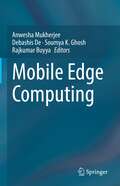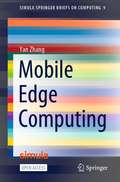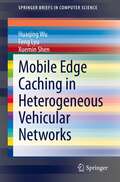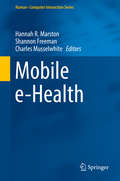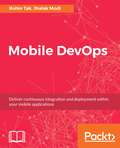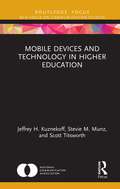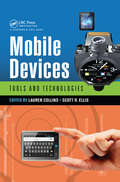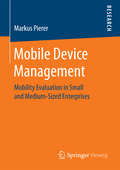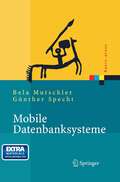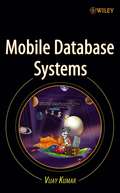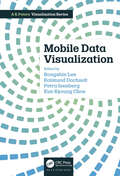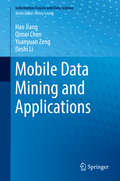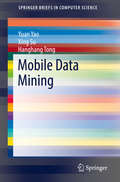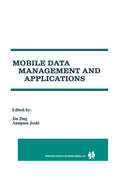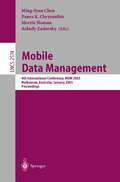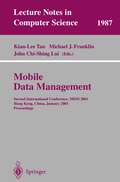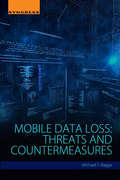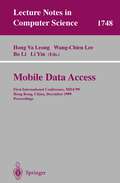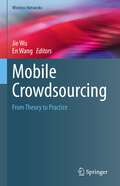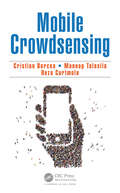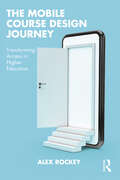- Table View
- List View
Mobile Edge Computing
by Anwesha Mukherjee Debashis De Soumya K. Ghosh Rajkumar BuyyaMobile Edge Computing (MEC) provides cloud-like subscription-oriented services at the edge of mobile network. For low latency and high bandwidth services, edge computing assisted IoT (Internet of Things) has become the pillar for the development of smart environments and their applications such as smart home, smart health, smart traffic management, smart agriculture, and smart city. This book covers the fundamental concept of the MEC and its real-time applications. The book content is organized into three parts: Part A covers the architecture and working model of MEC, Part B focuses on the systems, platforms, services and issues of MEC, and Part C emphases on various applications of MEC.This book is targeted for graduate students, researchers, developers, and service providers interested in learning about the state-of-the-art in MEC technologies, innovative applications, and future research directions.
Mobile Edge Computing (Simula SpringerBriefs on Computing #9)
by Yan ZhangThis is an open access book.It offers comprehensive, self-contained knowledge on Mobile Edge Computing (MEC), which is a very promising technology for achieving intelligence in the next-generation wireless communications and computing networks.The book starts with the basic concepts, key techniques and network architectures of MEC. Then, we present the wide applications of MEC, including edge caching, 6G networks, Internet of Vehicles, and UAVs. In the last part, we present new opportunities when MEC meets blockchain, Artificial Intelligence, and distributed machine learning (e.g., federated learning). We also identify the emerging applications of MEC in pandemic, industrial Internet of Things and disaster management.The book allows an easy cross-reference owing to the broad coverage on both the principle and applications of MEC. The book is written for people interested in communications and computer networks at all levels. The primary audience includes senior undergraduates, postgraduates, educators, scientists, researchers, developers, engineers, innovators and research strategists.
Mobile Edge Caching in Heterogeneous Vehicular Networks (SpringerBriefs in Computer Science)
by Huaqing Wu Feng Lyu Xuemin ShenTo support smart vehicular services especially in the future driverless era, the vehicular networks are expected to support high-bandwidth content delivery and reliable accessibility of multifarious applications. However, the limited radio spectrum resources, the inflexibility in accommodating dynamic traffic demands, and the geographically constrained fixed infrastructure deployment of current terrestrial networks pose great challenges in ensuring ubiquitous, flexible, and reliable network connectivity. This book investigates mobile edge content caching and delivery in heterogeneous vehicular networks (HetVNets) to provide better service quality for vehicular users with resource utilization efficiency enhancement. Specifically, this book introduces the background of HetVNets and mobile edge caching, provides a comprehensive overview of mobile edge caching-assisted HetVNet techniques in supporting vehicular content delivery, and proposes/designs mobile edge content caching and delivery schemes in different HetVNet scenarios respectively to enhance vehicular content delivery performance. Afterward, this book outlines open issues and research directions in future mobile edge caching-assisted space-air-ground integrated vehicular networks. The topics addressed in this book are crucial for both the academic community and industry, since mobile edge caching in heterogeneous networks has become an essential building block for the communication systems. The systematic principle of this book provides valuable insights on the efficient exploitation of heterogeneous network resources to fully unleash their differential merits in supporting vehicular applications. In addition, this book considers different HetVNet scenarios from terrestrial HetVNets to air-ground HetVNets and space-air-ground HetVNets, which can provide a general overview for interested readers with a comprehensive understanding of applying mobile edge caching techniques in enhancing vehicular content delivery performance, and offer a systematized view for researchers and practitioners in the field of mobile edge caching to help them design and optimize the desired vehicular content delivery systems.Provides in-depth studies on mobile edge content caching and delivery scheme design for three typical HetVNet scenarios;Comprehensively covers the analysis, design, and optimization of the mobile edge content caching-assisted HetVNets;Systematically addresses vehicle mobility, network service interruptions, and dynamic service request distribution issues in the mobile edge content caching and delivery.
Mobile e-Health (Human–Computer Interaction Series)
by Hannah R. Marston Shannon Freeman Charles MusselwhiteThis multi-disciplinary collection of essays captures discussion, thinking and research surrounding the recent surge of interest in how technology can help us as we age. A wide range of topics are covered, from investigations in the use of technology to improve health and well-being, to examinations of digital gaming, mobile health apps and the quantified self in relation to an ageing population. From multi-disciplinary perspectives, this collection highlights the role of a more social approach to technology. As such, a variety of social research methods are used throughout the chapters. The benefits and issues with different approaches are highlighted both in terms of further research, but also so the reader can judge the value of the research for themselves.This collection brings together the latest thinking and cutting edge contemporary research from leading thinkers and academics in the field of human computer interaction, health and gerontology. In taking a social approach, it highlights how technological practices fit within wider gerontological, political and cultural perspectives. It therefore has potential to influence those working in human computer interaction, digital humanities, sociology, psychology and gerontology. It can help change the practice of people working in the health and social care field, in computer and product design, and in the digital and creative industries.
Mobile DevOps Playbook: A practical guide for delivering high-quality mobile applications like a pro
by Moataz NabilLearn to use mobile DevOps for faster, more efficient mobile development by uncovering the secrets of mobile application development lifecycleKey FeaturesDiscover best practices and mobile DevOps tools for test automation, app releases, performance optimization, security, error tracking, and moreEnhance efficiency, speed, and quality of your development process with mobile DevOpsExplore mobile DevOps components like continuous integration, testing, deployment, and monitoringPurchase of the print or Kindle book includes a free PDF eBookBook DescriptionTo build mobile apps, you need to understand mobile-first features, tools, and processes that help you build, test, and release robust apps faster and more efficiently. The multitude of challenges stemming from mobile development's inherent complexities, including native iOS and Android app creation, cross-platform frameworks, and the implementation of scalable architectures within extensive teams, collectively contribute to a substantial number of obstacles that can significantly prolong the release process. This book will help you understand and implement the best practices of mobile DevOps for continuous integration, testing, delivery, deployment, and monitoring. You’ll explore different challenges faced by developers due to varied OSs, the unforgiving nature of mobile applications, and continuous updates to mobile phones and learn how to maneuver through these challenges. You’ll also get to grips with the latest trends while discovering the potential future of mobile DevOps, with valuable insights and guidance about integrating mobile development teams into your organization. By the end of this book, you’ll be well-equipped to successfully implement mobile DevOps and build fast, qualitative, and efficient mobile apps for your team or organization.What you will learnDiscover the principles, components, and concepts of mobile DevOpsDevelop a successful mobile CI/CD strategy in your organizationIdentify the tools and processes for mobile app release and distributionDevelop and release mobile applications efficiently and reliablyImplement continuous testing with mobile DevOpsLeverage Mobile DevSecOps to improve security, efficiency of your Mobile app development processUnderstand how Platform Engineering and IDP Teams can improve Developer Productivity in Mobile DevOpsIdentify and fix problems with mobile application performance and data usageWho this book is forThis book is for DevOps engineers looking to learn more about mobile DevOps to build effective processes for releasing mobile apps quickly and frequently. It’s also an excellent resource for mobile developers, mobile release managers, mobile architects, mobile platform engineers, and QA engineers, involved in mobile app development. Familiarity with DevOps and mobile app challenges related to testing, releasing, and monitoring especially at scale is a prerequisite.
Mobile DevOps: Deliver Continuous Integration And Deployment Within Your Mobile Applications
by Rohin TakToday's world is all about perfection, and there are hundreds of applications that are released each day out of which only a few succeed. Making sure that the app looks, performs, and behaves as expected is one of the biggest challenge developers face today.
Mobile Devices and Technology in Higher Education: Considerations for Students, Teachers, and Administrators (NCA Focus on Communication Studies)
by Jeffrey H. Kuznekoff Stevie M. Munz Scott TitsworthThis book examines key issues at the intersection of education and technology by addressing the question that most educators face—how do we use technology to engage students in the learning process and enhance learning? Problematizing the view that technology is the default solution to a host of problems facing education, while also recognizing that technology has an important place in a variety of education levels, the book provides readers with clear insights on technology and learning from a variety of perspectives from communication studies, education, and related disciplines. This volume is an essential read for scholars and teachers working in the area of elementary education. It will also be of interest to academics working in the area of education, postsecondary education, and learning and can be used as an ancillary text in graduate-level seminars.
Mobile Devices and Technology in Higher Education: Considerations for Students, Teachers, and Administrators (NCA Focus on Communication Studies)
by Jeffrey H. Kuznekoff Stevie M. Munz Scott TitsworthThis book examines key issues at the intersection of education and technology by addressing the question that most educators face—how do we use technology to engage students in the learning process and enhance learning? Problematizing the view that technology is the default solution to a host of problems facing education, while also recognizing that technology has an important place in a variety of education levels, the book provides readers with clear insights on technology and learning from a variety of perspectives from communication studies, education, and related disciplines. This volume is an essential read for scholars and teachers working in the area of elementary education. It will also be of interest to academics working in the area of education, postsecondary education, and learning and can be used as an ancillary text in graduate-level seminars.
Mobile Devices: Tools and Technologies
by Lauren Collins Scott R. EllisWireless and mobile communications have grown exponentially. The average individual now possesses a minimum of two smart mobile devices. The consistent advancement of mobile devices feeds the ever-growing appetite for faster bandwidth, uninterrupted connectivity, applications to fulfill the needs of consumers and businesses, and security for all of
Mobile Device Management: Mobility Evaluation in Small and Medium-Sized Enterprises
by Markus PiererIng. Markus Pierer M.Sc. proves whether or not there is a generic valid system comparison approach for various individual specifications facilitating the selection process for organizations. He illustrates important basics of enterprise mobility management, realizes classification of mobile devices and accomplishes conceptual definitions. The author divides feature descriptions in categories, thus making various different systems comparable and consistent. This comparison aims at integrating mobile devices in the existing infrastructure of small and medium-sized enterprises.
Mobile Datenbanksysteme: Architektur, Implementierung, Konzepte (Xpert.press)
by Bela Mutschler Günther SpechtMobile Database Systems
by Vijay KumarA breakthrough sourcebook to the challenges and solutions for mobile database systems This text enables readers to effectively manage mobile database systems (MDS) and data dissemination via wireless channels. The author explores the mobile communication platform and analyzes its use in the development of a distributed database management system. Workable solutions for key challenges in wireless information management are presented throughout the text. Following an introductory chapter that includes important milestones in the history and development of mobile data processing, the text provides the information, tools, and resources needed for MDS management, including: * Fundamentals of wireless communication * Location and handoff management * Fundamentals of conventional database management systems and why existing approaches are not adequate for mobile databases * Concurrency control mechanism schemes * Data processing and mobility * Management of transactions * Mobile database recovery schemes * Data dissemination via wireless channels Case studies and examples are used liberally to aid in the understanding and visualization of complex concepts. Various exercises enable readers to test their grasp of each topic before advancing in the text. Each chapter also concludes with a summary of key concepts as well as references for further study. Professionals in the mobile computing industry, particularly e-commerce, will find this text indispensable. With its extensive use of case studies, examples, and exercises, it is also highly recommended as a graduate-level textbook.
Mobile Data Visualization (AK Peters Visualization Series)
by Bongshin LeeMobile Data Visualization is about facilitating access to and understanding of data on mobile devices. Wearable trackers, mobile phones, and tablets are used by millions of people each day to read weather maps, financial charts, or personal health meters. What is required to create effective visualizations for mobile devices? This book introduces key concepts of mobile data visualization and discusses opportunities and challenges from both research and practical perspectives. Mobile Data Visualization is the first book to provide an overview of how to effectively visualize, analyze, and communicate data on mobile devices. Drawing from the expertise, research, and experience of an international range of academics and practitioners from across the domains of Visualization, Human Computer Interaction, and Ubiquitous Computing, the book explores the challenges of mobile visualization and explains how it differs from traditional data visualization. It highlights opportunities for reaching new audiences with engaging, interactive, and compelling mobile content. In nine chapters, this book presents interesting perspectives on mobile data visualization including: how to characterize and classify mobile visualizations; how to interact with them while on the go and with limited attention spans; how to adapt them to various mobile contexts; specific methods on how to design and evaluate them; reflections on privacy, ethical and other challenges, as well as an outlook to a future of ubiquitous visualization. This accessible book is a valuable and rich resource for visualization designers, practitioners, researchers, and students alike.
Mobile Data Visualization (AK Peters Visualization Series)
by Bongshin Lee Raimund Dachselt Petra Isenberg Eun Kyoung ChoeMobile Data Visualization is about facilitating access to and understanding of data on mobile devices. Wearable trackers, mobile phones, and tablets are used by millions of people each day to read weather maps, financial charts, or personal health meters. What is required to create effective visualizations for mobile devices? This book introduces key concepts of mobile data visualization and discusses opportunities and challenges from both research and practical perspectives. Mobile Data Visualization is the first book to provide an overview of how to effectively visualize, analyze, and communicate data on mobile devices. Drawing from the expertise, research, and experience of an international range of academics and practitioners from across the domains of Visualization, Human Computer Interaction, and Ubiquitous Computing, the book explores the challenges of mobile visualization and explains how it differs from traditional data visualization. It highlights opportunities for reaching new audiences with engaging, interactive, and compelling mobile content. In nine chapters, this book presents interesting perspectives on mobile data visualization including: how to characterize and classify mobile visualizations; how to interact with them while on the go and with limited attention spans; how to adapt them to various mobile contexts; specific methods on how to design and evaluate them; reflections on privacy, ethical and other challenges, as well as an outlook to a future of ubiquitous visualization. This accessible book is a valuable and rich resource for visualization designers, practitioners, researchers, and students alike.
Mobile Data Mining and Applications (Information Fusion and Data Science)
by Hao Jiang Qimei Chen Yuanyuan Zeng Deshi LiThis book focuses on mobile data and its applications in the wireless networks of the future. Several topics form the basis of discussion, from a mobile data mining platform for collecting mobile data, to mobile data processing, and mobile feature discovery. Usage of mobile data mining is addressed in the context of three applications: wireless communication optimization, applications of mobile data mining on the cellular networks of the future, and how mobile data shapes future cities. In the discussion of wireless communication optimization, both licensed and unlicensed spectra are exploited. Advanced topics include mobile offloading, resource sharing, user association, network selection and network coexistence. Mathematical tools, such as traditional convexappl/non-convex, stochastic processing and game theory are used to find objective solutions. Discussion of the applications of mobile data mining to cellular networks of the future includes topics such as green communication networks, 5G networks, and studies of the problems of cell zooming, power control, sleep/wake, and energy saving. The discussion of mobile data mining in the context of smart cities of the future covers applications in urban planning and environmental monitoring: the technologies of deep learning, neural networks, complex networks, and network embedded data mining. Mobile Data Mining and Applications will be of interest to wireless operators, companies, governments as well as interested end users.
Mobile Data Mining (SpringerBriefs in Computer Science)
by Yuan Yao Xing Su Hanghang TongThis SpringerBrief presents a typical life-cycle of mobile data mining applications, including:data capturing and processing which determines what data to collect, how to collect these data, and how to reduce the noise in the data based on smartphone sensors feature engineering which extracts and selects features to serve as the input of algorithms based on the collected and processed data model and algorithm designIn particular, this brief concentrates on the model and algorithm design aspect, and explains three challenging requirements of mobile data mining applications: energy-saving, personalization, and real-time Energy saving is a fundamental requirement of mobile applications, due to the limited battery capacity of smartphones. The authors explore the existing practices in the methodology level (e.g. by designing hierarchical models) for saving energy. Another fundamental requirement of mobile applications is personalization. Most of the existing methods tend to train generic models for all users, but the authors provide existing personalized treatments for mobile applications, as the behaviors may differ greatly from one user to another in many mobile applications. The third requirement is real-time. That is, the mobile application should return responses in a real-time manner, meanwhile balancing effectiveness and efficiency. This SpringerBrief targets data mining and machine learning researchers and practitioners working in these related fields. Advanced level students studying computer science and electrical engineering will also find this brief useful as a study guide.
Mobile Data Management and Applications
by Jin Jin Jing Anupam JoshiMobile Data Management and Applications brings together in one place important contributions and up-to-date research results in this fast moving area. Mobile Data Management and Applications serves as an excellent reference, providing insight into some of the most challenging research issues in the field.
Mobile Data Management: 4th International Conference, MDM 2003, Melbourne, Australia, January 21-24, 2003, Proceedings (Lecture Notes in Computer Science #2574)
by Ming-Syan Chen Panos K. Chrysanthis Morris Sloman Arkady ZaslavskyWe are rapidly heading towards a world in which the computing infrastructure will contain billions of devices, which will interact with other computing/communications devices that are carried or worn by users as they go through their daily routines. Such devices will provide data access to mobile users as they move within buildings, cities, or across the globe. This new infrastructure presents tremendous challenges for data management technology, including: huge scale; variable and intermittent connectivity; location and context-aware applications; bandwidth, power, and devi- size limitations; and multimedia data delivery across hybrid networks and systems. Traditional data management technologies such as query processing, transaction management, workflow, business process management, and metadata management must all be reevaluated in this emerging environment. Furthermore, nontraditional issues such as the semantics of mobile data, location-dependent querying, broadcast and multicast delivery, and caching/prefetching techniques must all be addressed. The ability to track people as they move about their daily tasks raises serious issues of security and privacy. This conference is the fourth in the Mobile Data Management series, focusing on the challenges and opportunities for the management of data in mobile, pervasive, and wearable computing. MDM 2000 and 2001 were in Hong Kong and MDM 2002 was in Singapore. Eighty-seven papers were submitted to the conference from 23 countries and were subject to a rigorous review procedure. Every paper had three or four independent reviews. Twenty-one full papers and 15 short papers from both academia and industry were selected for publication in this volume of proceedings.
Mobile Data Management: Second International Conference, MDM 2001 Hong Kong, China, January 8-10, 2001 Proceedings (Lecture Notes in Computer Science #1987)
by Kian-Lee Tan Michael J. Franklin John C. S. LuiWelcome to the Second International Conference on Mobile Data Management (MDM2001). The conference serves as a forum for the exchange of technical ideas and research results in the areas of mobility and database management. This year, we have a very exciting program for MDM2001. Many quality papers were submitted to the conference. All of the submitted papers were - viewed by at least three PC members. Due to the limitations of the program schedule as well as the desire to organize the conference using a single track format, we selected only 18 papers for full presentation at the conference. As a result many excellent papers could not be accepted. The papers chosen for presentation span a large range of topics, from n- work protocol issues up to the semantics of mobile applications. The common theme of all these papers is their recognition of the central role played by data managementtechniques in the developmentof the emerging worldof mobile and wireless applications. We have loosely organized these papers into six areas: 1. DATA MANAGEMENT ARCHITECTURES, 2. CONTENT DELIVERY, 3. DATA BROADCASTING, 4. CACHING AND HOARDING, 5. COPING WITH MOVEMENT, 6. NETWORKS AND SYSTEMS ISSUES In addition to the researchtrack, we havesought to broaden the scope of the conference with an industrial session as well as poster presentations. Overall, the program strikes a comfortable balance between applied and theoretically oriented papers.
Mobile Data Loss: Threats and Countermeasures
by Michael T. RaggoThe mobile threat landscape is evolving bringing about new forms of data loss. No longer can organizations rely on security policies designed during the PC era. Mobile is different and therefore requires a revised approach to countermeasures to mitigate data loss. Understanding these differences is fundamental to creating a new defense-in-depth strategy designed for mobile. Mobile Data Loss: Threats & Countermeasures reviews the mobile threat landscape using a hacker mind-set to outline risks and attack vectors that include malware, risky apps, operating system compromises, network attacks, and user behaviours. This provides the basis for then outlining countermeasures for defining a holistic mobile security methodology that encompasses proactive protections, response mechanisms, live monitoring, and incident response. Designing a comprehensive mobile security strategy is key. Mobile Data Loss: Threats & Countermeasures outlines the threats and strategies for protecting devices from a plethora of data loss vectors. Outlines differences in mobile devices versus PCsReviews mobile threat landscape using a hacker mind-set to outline risks and attack vectorsSummarizes the tools and techniques for implementing enterprise countermeasuresMaps mobile to common security compliances including PCI, HIPAA, and CJISProvides a defense-in-depth methodology and strategy for enterprises to minimize data loss
Mobile Data Access: First International Conference, MDA'99, Hong Kong, China, December 16-17, 1999 Proceedings (Lecture Notes in Computer Science #1748)
by Hong Va Leong Wang-Chien Lee Bo Li Li YinMobile Crowdsourcing: From Theory to Practice (Wireless Networks)
by Jie Wu En WangThis book offers the latest research results in recent development on the principles, techniques and applications in mobile crowdsourcing. It presents state-of-the-art content and provides an in-depth overview of the basic background in this related field. Crowdsourcing involves a large crowd of participants working together to contribute or produce goods and services for the society. The early 21st century applications of crowdsourcing can be called crowdsourcing 1.0, which includes businesses using crowdsourcing to accomplish various tasks, such as the ability to offload peak demand, access cheap labor, generate better results in a timely matter, and reach a wider array of talent outside the organization. Mobile crowdsensing can be described as an extension of crowdsourcing to the mobile network to combine the idea of crowdsourcing with the sensing capacity of mobile devices. As a promising paradigm for completing complex sensing and computation tasks, mobile crowdsensing serves the vital purpose of exploiting the ubiquitous smart devices carried by mobile users to make conscious or unconscious collaboration through mobile networks. Considering that we are in the era of mobile internet, mobile crowdsensing is developing rapidly and has great advantages in deployment and maintenance, sensing range and granularity, reusability, and other aspects. Due to the benefits of using mobile crowdsensing, many emergent applications are now available for individuals, business enterprises, and governments. In addition, many new techniques have been developed and are being adopted. This book will be of value to researchers and students targeting this topic as a reference book. Practitioners, government officials, business organizations and even customers -- working, participating or those interested in fields related to crowdsourcing will also want to purchase this book.
Mobile Crowdsensing
by Cristian Borcea Manoop Talasila Reza CurtmolaMobile crowdsensing is a technology that allows large scale, cost-effective sensing of the physical world. In mobile crowdsensing, mobile personal devices such as smart phones or smart watches come equipped with a variety of sensors that can be leveraged to collect data related to environment, transportation, healthcare, safety and so on. This book presents the first extensive coverage of mobile crowdsensing, with examples and insights drawn from the authors’ extensive research on this topic as well as from the research and development of a growing community of researchers and practitioners working in this emerging field. Throughout the text, the authors provide the reader with various examples of crowdsensing applications and the building blocks to creating the necessary infrastructure, explore the related concepts of mobile sensing and crowdsourcing, and examine security and privacy issues introduced by mobile crowdsensing platforms. Provides a comprehensive description of mobile crowdsensing, a one-stop shop for all relevant issues pertaining to mobile crowdsensing, including motivation, applications, design and implementation, incentive mechanisms, and reliability and privacy. Describes the design and implementations of mobile crowdsensing platforms of great interest for the readers working in research and industry to quickly implement and test their systems. Identifies potential issues in building such mobile crowdsensing applications to ensure their usability in real life and presents future directions in mobile crowdsensing by emphasizing the open problems that have to be addressed.
Mobile Crowdsensing
by Cristian Borcea Manoop Talasila Reza CurtmolaMobile crowdsensing is a technology that allows large scale, cost-effective sensing of the physical world. In mobile crowdsensing, mobile personal devices such as smart phones or smart watches come equipped with a variety of sensors that can be leveraged to collect data related to environment, transportation, healthcare, safety and so on. This book presents the first extensive coverage of mobile crowdsensing, with examples and insights drawn from the authors’ extensive research on this topic as well as from the research and development of a growing community of researchers and practitioners working in this emerging field. Throughout the text, the authors provide the reader with various examples of crowdsensing applications and the building blocks to creating the necessary infrastructure, explore the related concepts of mobile sensing and crowdsourcing, and examine security and privacy issues introduced by mobile crowdsensing platforms. Provides a comprehensive description of mobile crowdsensing, a one-stop shop for all relevant issues pertaining to mobile crowdsensing, including motivation, applications, design and implementation, incentive mechanisms, and reliability and privacy. Describes the design and implementations of mobile crowdsensing platforms of great interest for the readers working in research and industry to quickly implement and test their systems. Identifies potential issues in building such mobile crowdsensing applications to ensure their usability in real life and presents future directions in mobile crowdsensing by emphasizing the open problems that have to be addressed.
The Mobile Course Design Journey: Transforming Access in Higher Education
by Alex RockeyThe Mobile Course Design Journey provides practical strategies to college and university educators and faculty support professionals looking to develop accessible mobile learning experiences. Given the near-ubiquity of mobile device ownership today, creating courses that can be completed entirely on a mobile device is essential to captivating student attention and supporting equity-minded pedagogy. This book frames effective mobile design within a continuum in which educators can make gradual yet meaningful changes to their instruction and course content while leveraging learners’ existing tools and literacies. Original, ready-to-use features such as a rubric for evaluating the mobile-friendliness of course content and assignments as well as a toolkit for leading workshops on mobile design will further help to demystify mobile learning in higher education.
